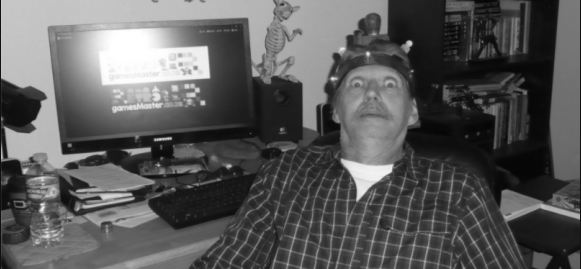
Tragically Doug passed away on 4th June 2017 and very sad by this news I had the pleasure of some online chats and the last thing Doug said to me was “You know, I have such admiration and respect for the young people whom are retro game lovers. These’s a special magic and in the early games…and these young people see it. Awesome.
Please take care of yourself and I wish you the best of health and fortune. -Doug”
Retro Interview: Doug Barnett by Peter Ward
Bio
Doug Barnett has worked on games as early as 1984 and as recently as 2003. He has been credited with Design, Graphics / Artwork, Additional Graphics / Artwork, Writing / Dialogue / Story and Design Consultation. He has worked with the following game development companies: Dynamix, Activision, Inc., Strategic Simulations, Inc., Totally Games, Inc., Lucasfilm, Walt Disney Studios, Netcom, Learning Company, Electronic Arts, Gamestar, Grolier Interactive, MGM and Cinemaware.
Games included are: Star Rank Boxing (1986), Gamestar; Lords of the Rising Sun (1989), Cinemaware; Star Wars: X-Wing Alliance (1999), LucasArts; Return to Zork (1993), Activision, Inc.; Shanghai II: Dragon’s Eye (1990), Activision, Inc.; Ghostbusters 2 (1989), Activision, Inc.; The Last Ninja (1988), Activision, Inc.; Pool of Radiance (1988), Strategic Simulations, Inc.; Robin Hood (2003), Cinemaware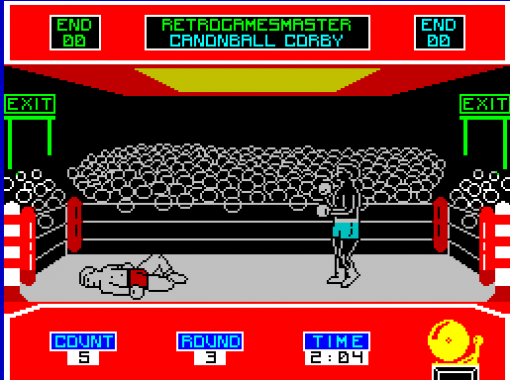
Click here for extensive feature review on this game
Thank you for this interview it is an honour for me to interview such a Legend….
Q: What did you want to do when you were at school for a career and what was your first job?
A: I originally wished to be an archaeologist or anthropologist. I was detoured by art (oil painting) and music (blue harp & violin). Having married early (age 19), my first job was taking inventory at a junkyard (no kidding). From there, miraculously, I lassoed a gig at Sony in the parts department…eventually moving up to Supervisor for International Inventory Control at Superscope/Marantz. After going through a divorce, I bought a one-way ticket to Zurich, Switzerland. I moved to Heidelberg, Germany for 3 years, writing for American magazines. Then, on to Hastings, England for 2.5 years, writing and teaching English and American Slang at a private college.
Ironically, while in Germany, I wrote a one-page article on how to prevent video games burning images onto TV screens….but I had yet to even touch a video game machine (Atari at the time).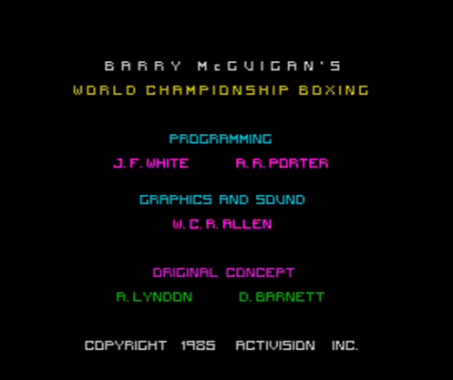
Q: What was your first computer and was that your favourite computer or do you have a different favourite?
A: My first computer was a VIC-20. However, by the time I had finished designing a couple games, the machine was obsolete. Enter the Commodore 64. The C64 was a great machine. I taught myself BASIC and Assembly Language programming for it, as well as investigating its inner workings. The C64 was my favorite computer until the Amiga arrived.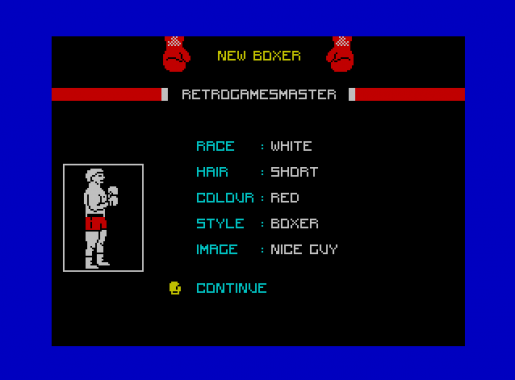
Q: Is this the computer you learnt to program on?
A: Yes, the C64 was fairly easy to program on. In only 8 months, I went through the VIC-20 phase and C64 learning process to complete 2 working demos with graphics (“Main Event” Boxing – Barry McGuigan and “Canvas Falcons” – a WW1 RPG aerial combat game). Graphics on the C64 I found to be great fun and became quite good graphically and with sprites. This enabled many independent graphics gigs on the side (Pool of Radiance, Shanghai, Last Ninja 2, Howard the Duck, etc.).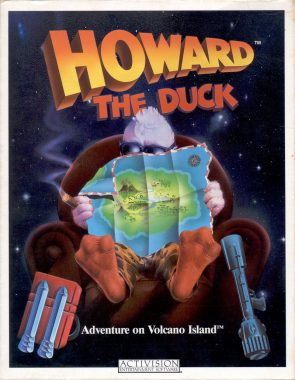
Q: When and how did you to get into game industry?
A: It was 1985 and I was living in Baltimore, Maryland. I was playing a lot of Intellivision games then and working on a novel. I was married again (to a lawyer) and my wife wasn’t too pleased with what appeared to her as my ‘doing nothing’ all day (writers are never taken seriously until they have a bestseller). So I decided to design video games and bought the Vic-20, then the C64. This decision lead to a divorce (she thought I had lost my mind), but started the whole video game career. When my “Main Event” boxing game demo was ready, I flew to California to sell it. First, I went to Electronic Arts, but they had been hit by serious thunder storms and were unable to look at the demo. Rather than leave it with them, I went to Gamestar in Santa Barbara (later acquired by Activision). Gamestar bought “Main Event” (Star Rank Boxing)….and off everything went!
Basically, I got lucky on my first shot.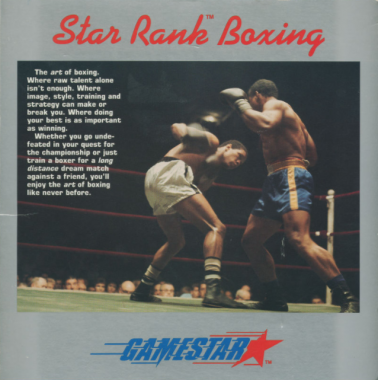
Q: I understand your first game was Star Rank Boxing (aka Barry McGuigan) and you had the original concept for this game. What inspired you to make a boxing game?
A: I’ve always been a fan of boxing (and NASCAR). The elements of boxing, I felt, were perfect for a computer game. After viewing the other boxing games at the time, I felt so much was missing, especially graphically. And I wanted the subject matter to be instantly understood.
Q: I cannot remember any other boxing game back in 1986 that had a management and training section. Was this the first game to do this? If so, did you set president for all future Boxing games?
A: Yes, I believe it was the first boxing game to include “role-playing” aspects that actually made a difference in the game. The original design also included modem play, but Gamestar felt it was unnecessary or not feasible (I thought it possible, even with 14.4 modems…who knows). I also would have liked to include managers of varying qualities and outside-the-ring lifestyles, but I don’t think these were mentioned in the design presented to Gamestar. Boxing games that followed the success of Star Rank Boxing did seem to have been influenced, but that’s a good thing.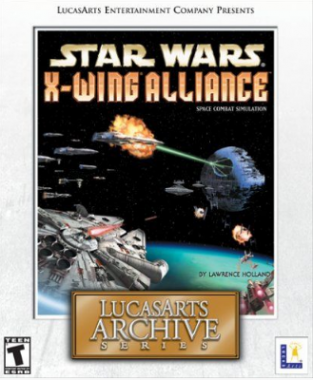
Q: I understand Star Rank was awarded sports game of the year in 1986 this must have been a great honour especially as it was your first game?
A: Yes! How fortunate and thrilled I was, indeed. I wish all designers could experience that feeling.
Q: How many of the boxer’s names in the game were inspired by the developer’s such as Boom Boom Barnett?
A: Hahaha…Many! I think some of the names I had put in were used, too, but everyone involved wanted in on the fun, which was great. The “Boom Boom” was a tribute to Ray Mancini, the WBA lightweight championship from 1982 to 1984. I loved to watch sluggers in action…Barry McGuigan, Ray Mancini, Mike Tyson, Marvin Hagler, and my all-time favorite Rocky Marciano.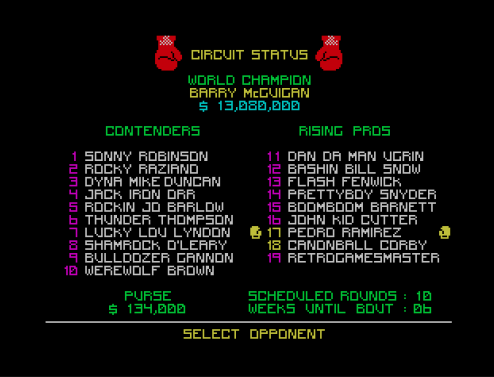
Q: You have worked with many companies such as Dynamix, Activision, Inc., Strategic Simulations, Inc., Totally Games, Inc., Lucasfilm, Walt Disney Studios, Netcom, Learning Company, Electronic Arts, Gamestar, Grolier Interactive, MGM and Cinemaware. Which was your favourite company to work with and your least?
A: I don’t have a ‘least favorite’, so to speak. I enjoyed what I was doing too much. I have a strong sense of loyalty to Activision because of the many opportunities they offered me over the years, and the fine people I met there, even though a few designs/projects I loved were scuttled there for strange reasons.
The most fun development experience was with Walt Disney Studios; the people I worked with were absolutely awesome. Cinemaware was exciting, too, probably because it was my second game (Lords of the Rising Sun) and I was in Heaven designing games.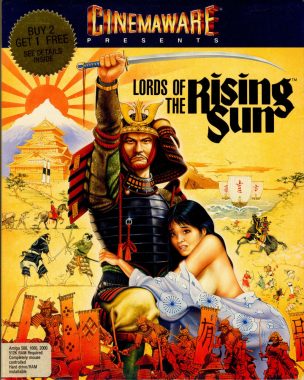
Q: You worked on many games such as Star Rank Boxing (1986), Gamestar; Lords of the Rising Sun (1989), Cinemaware; Star Wars: X-Wing Alliance (1999), LucasArts; Return to Zork (1993), Activision, Inc.; Shanghai II: Dragon’s Eye (1990), Activision, Inc.; Ghostbusters 2 (1989), Activision, Inc.; The Last Ninja (1988), Activision, Inc.; Pool of Radiance (1988), Strategic Simulations, Inc.; Robin Hood (2003), Cinemaware. What was your favourite and why and which one was your least favourite and why? (any concept or notes etc.)
A: Star Rank Boxing and Lords of the Rising Sun were my favorites (my son and I played Star Rank Boxing to death), mostly because I had more control over the quality of the final product. The Disney project (Pirates of the Caribbean 1991) would have been a tremendous product and no doubt a favorite had it made it to market. The people I work with on a project make all the difference in the world.
My least favorite project, I suppose, was Return to Zork. Being a freelance designer, I wasn’t kept adequately informed of progress or changes as it went along. Not to mention that when Activision called me for a design, it was already “due yesterday”, so the design was not as ‘neat’ as I would have preferred. There were good people on the project, though, which was a good thing.
Q: You did the art and graphics on Ghostbusters 2, which versions did you work on did you get to meet anyone from the movies? (Concept art id any please)
A: I only did the animated title screen and design for Ghostbusters 2. A group of talented artists at Activision did the graphics throughout the game. Unfortunately, I did not get to meet any of the actors from the movie….rats! Meeting actors and Hollywood people associated with game contracts came later in the 90s…beginning with Return to Zork.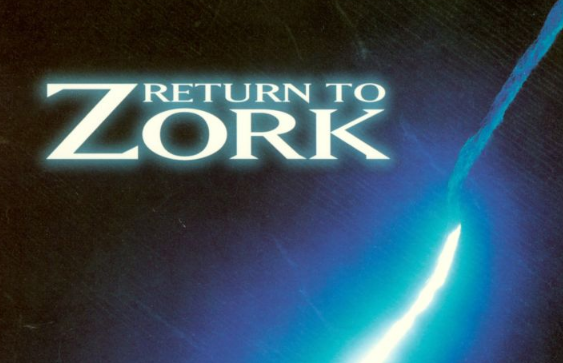
Q: You also did the Title screen for The Last Ninja 2, please tell us how this come about?
A: I had a knack for getting the most of C64 graphics and word got around. So various companies would call me for graphics help, especially for large, scrolling maps on the C64 (Pool of Radiance, Howard the Duck, etc.). As for animated title screens….I just enjoyed doing them (Howard the Duck, Ghostbusters 2, Last Ninja 2, GBA Championship Basketball, etc.). I liked doing logos, too (Netcom, WilDial, etc.). I reworked the Gamestar logo on the C64 for Star Rank Boxing, just for fun.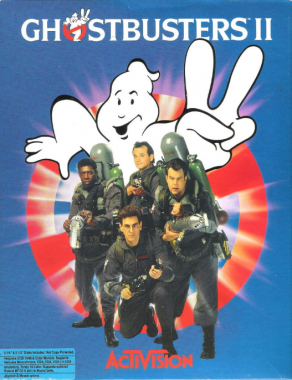
Q: Are you still making games? If not, why did you leave the industry?
A: No, I haven’t been involved in games for a few years, other than Cinemaware calling and suggesting the possibility of a Lords of the Rising Sun 2. However, after saying that I’d be happy to do it, they never followed up…so it’s been left hanging in limbo. Once in the video game business, as all players know, you never really escape its lure. I still play certain games on the PC: Total War: Napoleonic and Rome 2, Skyrim, Mount & Blade, Rise of Flight. I fiddle around with other ones, but the listed ones dominate.
I would like to sell a couple original game design documents and consult as they’re being produced, but this may never be realized, as I haven’t made any attempts to do so.
The industry changed quite a bit and I guess the thrill has been watered down. I prefer the earlier structure of game development. Like games, the desire to return to story-telling is inescapable. So, if health allows, I wish to finish a few writing projects.
Q: Tell us what you’re currently working on?
A: A series of children’s books with the artist Jeannie Vodden.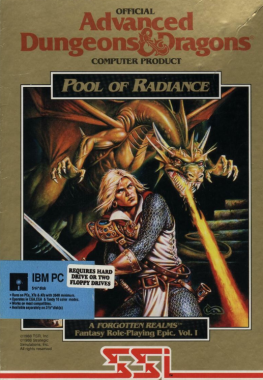
Q: I enjoy some modern games, but feel more love for the smaller teams of the past. I feel the fun factor has gone in modern games and are more like movie productions; games can be bug ridden now as patches can be made. In the past we didn’t have updates and in app purchases. What is your view of our industry now?
A: I agree with you. The video game industry has changed dramatically, and the fun factor is diminished greatly. Innovative games have mostly come from new, independent development groups. These groups are then eaten up by huge publishers and, for some reason, they disappear, lose quality, or end up merely doing sequels. Sometimes sequels work (Morrowind-Oblivion-Skyrim, Call of Duty series), but plotlines and action seem to become repetitive. And I HATE constant bug updates!!
Here are some questions about retro games:
Q: My favourite computer was my Amiga and 2 of my favourite games were Cannon Fodder and SWOS 🙂 and my favourite console the Megadrive do you have a favourite?
A: I also loved the Amiga. It truly opened up gaming possibilities. I still have a C64, Amiga and Sega Genesis. I think I still have an Intellivision, but haven’t located it yet. My first console was the Intellivision, which had some great games…and I liked the controller. I have trouble with console controllers, preferring to use a mouse and keyboard.
Q: What is your favourite retro game?
A: Probably “Seven Cities of Gold” (1984 Ozark Software/EA). But just to be annoying, here is a list of favorites over the early years:
Defender (1981-WMS)
Zaxxon (1982-Sega)
Choplifter (1982-Dan Gorlin-Sega)
Fire Power (1987-Micro Illusions, Amiga)
Red Baron (1990-Dynamix)
Duke Nukem (1991-Apogee)
Sonic the Hedgehog (1991-Sega)
SWOTL (1991-LucasArts)
Lemmings (1991-Psygnosis) * Psygnosis made many great games.
Empire Deluxe (1993-New World Computing)
Master of Orion (1993-Microprose)
NASCAR Racing (1994-Papyrus)
Panzer General (1994-Strategic Simulations)
Outlaws (1997-LucasArts)
Escape From Monkey Island (2000-LucasArts)
Q: Do you still game on the current consoles if so what’s your favourite game?
A: Not long ago, I got my butt kicked royally on an X-Box…all due to my ineptness on the controller. I am not a console fan because I like to experiment with Mods, which, for me, makes the PC superior. I’ve used over 140 mods for Skyrim, which have extended Skyrim’s life tremendously.
Q: What’s the worst game you have ever played?
A: THAT is a tough question – there were so many disappointments. Basically, any game that:
(a) constantly crashed, (b) didn’t have a Save Game feature, (c) having an interface from hell.
